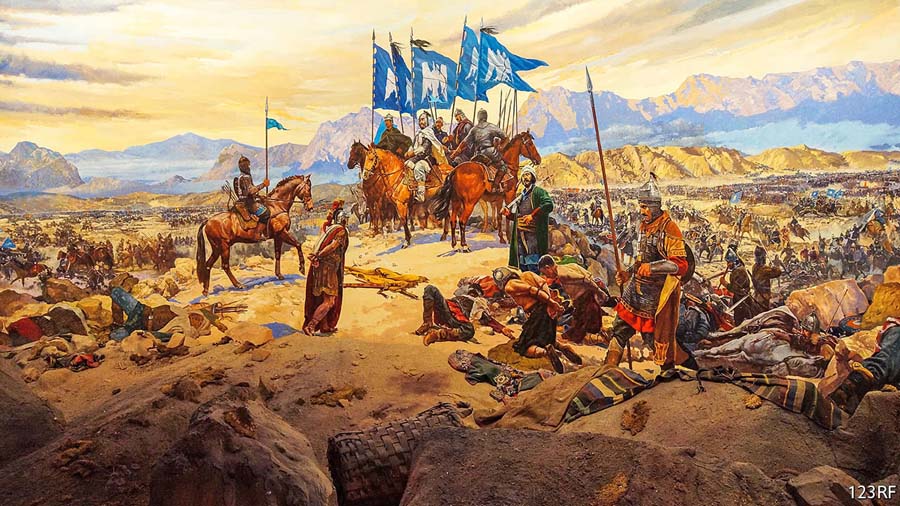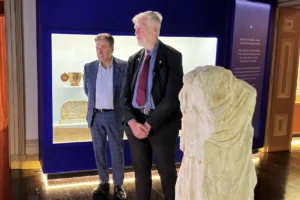The outlook of current Western leaders suggests that humanity will be hard pressed to survive the 21st century
Talk about a graphic display of soft power: Beijing this week hosted the Conference on Dialogue of Asian Civilizations.
Organized under the direct supervision of President Xi Jinping it took place amid an “Asian Culture Carnival.” Sure, there were dubious, kitschy and syrupy overtones, but what really mattered was what Xi himself had to say to China and all of Asia.
In his keynote speech, the Chinese leader essentially stressed that one civilization forcing itself upon another is “foolish” and “disastrous.” In Xi’s concept of a dialogue of civilizations, he referred to the New Silk Roads, or Belt and Road Initiative (BRI), as programs that “have expanded the channels for communication exchanges.”
Xi’s composure and rationality present a stark, contrasting message to US President Donald Trump’s “Make America Great Again” campaign.
West vs East and South
Compare and contrast Xi’s comments with what happened at a security forum in Washington just over two weeks earlier. Then, a bureaucrat by the name of Kiron Skinner, the State Department’s policy planning director, characterized US-China rivalry as a “clash of civilizations,” and “a fight with a really different civilization and ideology the US hasn’t had before.”
And it got worse. This civilization was “not Caucasian” – a not so subtle 21st century resurrection of the “Yellow Peril.” (Let us recall: The “not Caucasian” Japan of World War II was the original “Yellow Peril.”)
Divide and rule, spiced with racism, accounts for the toxic mix that has been embedded in the hegemonic US narrative for decades now. The mix harks back to Samuel Huntington’s The Clash of Civilizations and the Remaking of World Order, published in 1996.
Huntington’s pseudo-theory, coming from someone who did not know much about the multi-polar complexity of Asia, not to mention African and South American cultures, was mercilessly debunked across vast swathes of the global South. In fact, Huntington did not even come up with the original, flawed concept. That was the work of Anglo-American historian and commentator Bernard Lewis, who passes for a Middle East guru in the US.
Divide, rule, conquer
As Alastair Crooke, the founder of the Conflicts Forum, has outlined, Lewis consistently preached divide and rule, tinged with racism, in Islamic states. He was a fervent proponent of regime change in Iran and his recipe for dealing with Arabs was “to hit them between the eyes with a big stick” because, in his world view, the only thing they respect is power.
Crooke reminds us that since the 1960s, Lewis has been a master at spotting vulnerabilities in “religious, class and ethnic differences as the means to bring an end to Middle Eastern states.” Lewis is a hero across a certain spectrum – a spectrum that includes former US Vice President Dick Cheney and US Secretary of State Mike Pompeo.
Now, we live in the era of “Lewis redux.” Given that the Islamic world is largely subdued, in torpor or in turmoil, the clash of civilizations basically applies, on a downsized scale, to containing or destroying Shi’ite Iran.
Meanwhile the real clash – as the State Department insists – is with China.
Huntington, the sub-Lewis, did not include Russia among “The West.” The revisionist State Department does. Otherwise how could “Nixon in reverse”be justified? (“Nixon in reverse,” let us remember, is the Kissingerian recommendation to President Donald Trump: Apply divide and rule between Russia and China – but this time seducing Russia.)
A revisionist Pentagon also came up with the “Indo-Pacific” concept. The only justification for the amalgam is that these two zones should conduct a foreign policy subjected to American hegemony.
The logic is always divide and rule and clash of civilizations – divisions provoking chaos all across Eurasia.
But this strategy is being applied against the background of a crucial historical juncture: The era when BRI is being configured as the road map for progressive Eurasian integration.
Quo vadis, humanity?
It’s not hard to detect the faintest of smiles on the faces of Chinese strategists as they survey “The Big Picture” from the vantage point of 5,000 years of civilization. The Christian West as the unique road map to deliver humanity from evil – in fact, the foundation of Pax Americana – is regarded as an amusing fiction at best.
That fiction is now looking downright dangerous, wallowing in exceptionalism and demonization of “The Other” in myriad forms. The Other – from the Islamic Republic of Iran to atheist China, not to mention “autocratic” Russia – automatically qualifies as a manifestation of “evil.”
China, by contrast, is polytheist, pluralist, multi-polar – embracing Confucianism, Buddhism, Taoism. That is mirrored by the current drive towards a multi-polar world-system. What matters is unity in multiplicity – as Xi stressed in his keynote speech. In it, we find China and Persia, two ancient civilizations – not by accident linked by the Ancient Silk Road – thinking alike.
Then there’s the appalling state of the planet, which dwarfs the current appalling spectacle of political madness. UCLA geographer and global best-selling author Jared Diamond is not being terribly precise, but he estimates there’s a 49% chance “that the world as we know it will collapse by about 2050.”
As encapsulated by author Nafeez Ahmad: “Over the last 500 years or so, humanity has erected an ‘endless growth’ civilization premised on a particular patchwork of ideological worldviews, ethical values, political and economic structures, and personal behaviors. This is a paradigm that elevates the vision of human beings as disconnected, atomistic, competing material units, which seek to maximize their own material consumption as the principal mechanism for self-gratification.”
What we’re living now is not a clash of civilizations; it’s a crisis of civilization.
If the paradigm under which most of humanity barely survives is not changed – and there’s precious little evidence it will – there won’t be any civilizations left to clash.
Pepe Escobar is correspondent-at-large at Asia Times. His latest book is 2030. Follow him on Facebook.
This article was originally published by “Asia Times”-
By Pepe Escobar
The views expressed in this article are solely those of the author and do not necessarily reflect the opinions of TA NEA NEWSPAPER AND 3XY RADIO.












